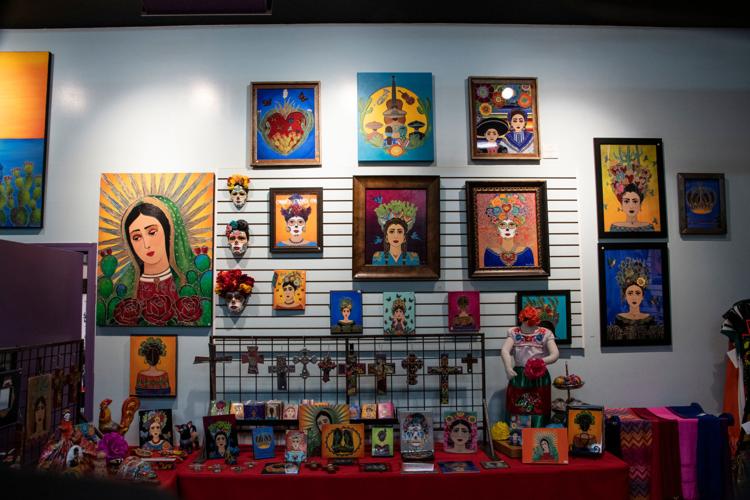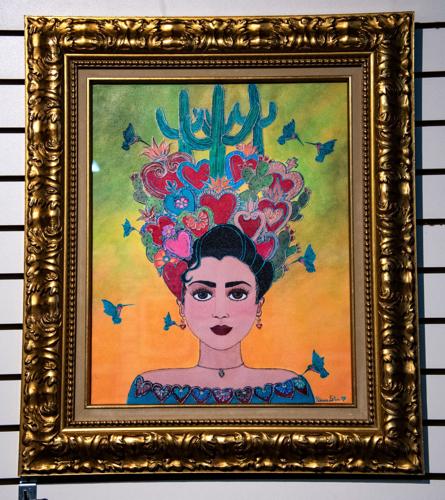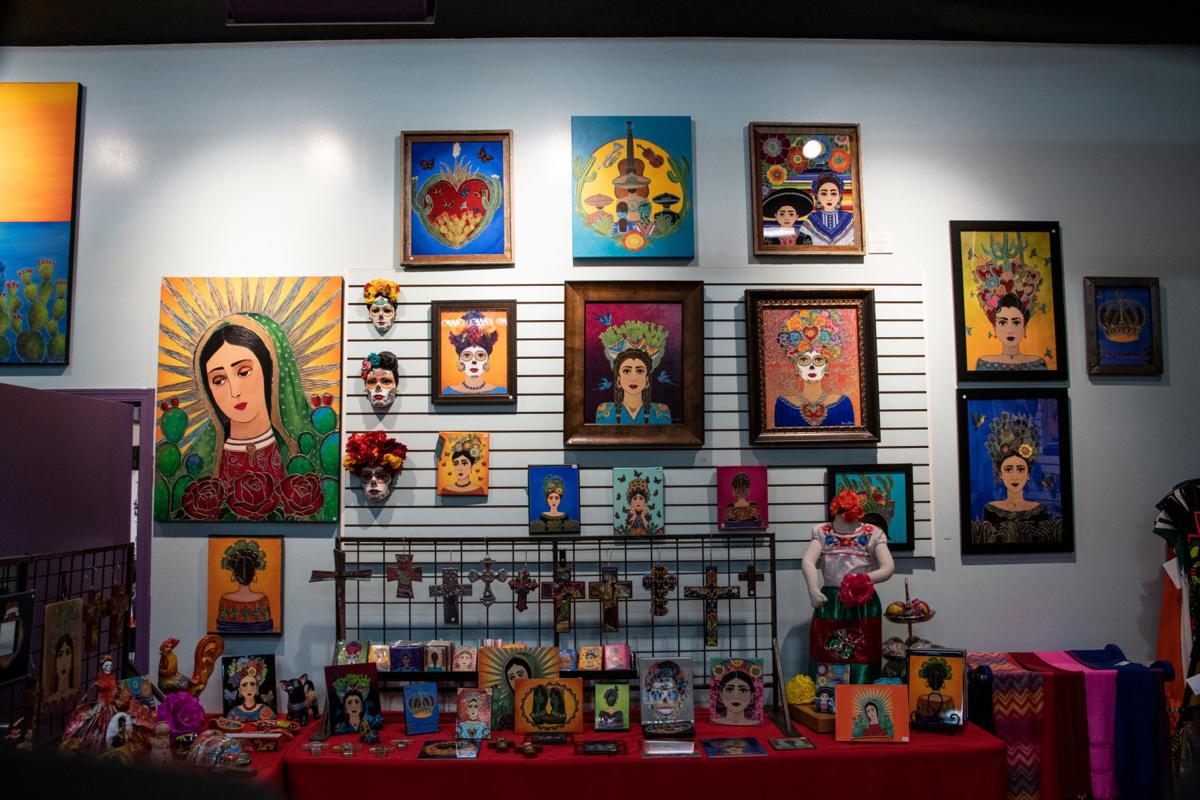ENGLISH VERSION BELOW
Los vestigios de su vida y su mundo impregnan todos los rincones del arte vibrante de Patricia González Silva.
Los colores audaces de su cultura mexicana, los cactus y las suculentas del desierto de Tucsón, las representaciones simbólicas de la familia y los ancestros y los innumerables tonos de nuestras puestas de sol vibran en los lienzos y las cerámicas pintadas que ella convierte meticulosamente en obras de arte singulares.
Silva se está adentrando en sí misma en estos días, con su trabajo siendo vendido a clientes en Tucsón y Scottsdale y siendo enviado a diferentes lugares, llevando un poco de Tucsón al mundo.
Ella trabaja donde puede. A veces, en el garaje que su esposo, Adam Silva, convirtió en un estudio para ella, a veces en habitaciones de hotel y casi en cualquier otro lugar donde el tiempo y la inspiración se crucen.
“Mi hija estuvo en el hospital recientemente”, dice. “Me senté ahí con todas las emociones por las que estaba pasando y pude crear. Así que cualquier lugar donde pueda encontrar algo de tiempo para reflexionar me inspira”.
Su propio viaje como artista se remonta a la infancia cuando a los 6 años vio a su hermana mayor, Julie Gallego, aprender a bailar folclórico y comenzó a escalar. Su padre, Ralph González, un militar retirado de la Fuerza Aérea, era un artista visual (e historiador) talentoso por derecho propio.
“Mi papá solía pintar hermosos nacimientos en nuestras ventanas durante la Navidad que parecían vidrieras”, recuerda.
Aunque todavía le faltaba algo de confianza cuando fue a la escuela de arte a mediados de sus años 20’s, Silva comenzó a ver que tenía talento cuando su diseño fue elegido entre más de 50 concursantes para convertirse en el registro del Bank of Tucson.

Patricia Silva frente a las gigantes catrinas que creó hace años para el Arizona Centennial Best Fest.
En 2012, Julie Gallego y Tim Escobedo fueron elegidos para crear un pueblo mexicano para la celebración del Arizona Centennial’s Best Fest, que también presentaba áreas que celebraban las culturas de los indios americanos y los vaqueros de Arizona. Julie recurrió a su hermana menor para construir hermosos y grandes maniquíes del Día de los Muertos, colocados prominentemente en esa área de la celebración del centenario. Ese proyecto aumentó la confianza de Silva y la hizo pensar en crear su propio trabajo.
Silva durante algún tiempo había estado ayudando a Julie con su grupo de danza Viva Performing Arts en sus espectáculos y las producciones más grandes de Viva Arizona. Los espectáculos de Viva Arizona era una historia de bailes de la población mexicana de Tucsón desde los días precoloniales hasta los tiempos modernos, cada uno centrado en un aspecto particular de Tucsón, desde sus pioneros de la radio en español hasta los antiguos salones y barrios de la ciudad.
Fue un trabajo familiar. Su padre escribía la narración, Julie lo coreografiaba todo, desde folclórico hasta swing, rock y más, y Patricia colaboraba con sets, accesorios, tocados y más. Esos espectáculos de la década de 1990 y principios de 2000 fueron algunas de las presentaciones originales más memorables y extraordinarias de su época.

Cuadro de la serie Ladies of the Desert de Patricia Silva.
Todas estas experiencias, los innumerables colores y formas del México regional y las imágenes y sonidos de Tucsón se abren paso en las creaciones estilizadas de Silva. Para 2014, se había salido de esas carreras, viendo crecer sus habilidades y encontrando satisfacción en la realización de las visiones de su cabeza.
Silva tiene una serie de retratos femeninos característicos que a menudo se confunden con representaciones de la reconocida pintora mexicana Frida Kahlo.

Reina del Corazón, de Patricia Silva.
“Frida Kahlo fue una gran inspiración cuando empecé”, dice. “Me relacioné con sus luchas y sufrimientos como artista y mujer. Pero como explico a las personas que preguntan, estas son mis Damas del Desierto. Puse mi cultura hispana y la belleza de Arizona en esas piezas”.
Una pintura exquisita se titula Reina del Corazón.
“He tenido mis propias luchas por no creer en mí misma, así que pongo mis luchas y las cosas importantes de mi vida en mi cabeza como una corona en lugar de pensar ‘¡ay de mí!”, dice. “Los tres cactus en la parte superior simbolizan a mis tres hijas. Los colibríes simbolizan a nuestros seres queridos que han fallecido, y el de la izquierda simboliza a mi padre para recordarme que siempre ha estado allí para mí a través de mis luchas y que él sigue estando allí para mí en espíritu”.

Exterior del edificio Viva Performing Arts Center, donde se exhibe y vende el arte de Patricia Silva, hermana de la bailarina y coreógrafa Jullie Gallego, quien tiene ahí mismo su estudio de danza y una tienda de artículos religiosos.
El colorido trabajo de Silva se exhibe en el Viva Performing Arts Center, 4563 S Park Ave., donde también se ubica el estudio de danza Viva y la tienda de artículos religiosos de Julie, Ave María. Es una especie de centro cultural mexicano con productos importados de México, suministros folclóricos y más.
A pesar de que el coronavirus tiene a la gente refugiada en sus casas, ella lo ve como una bendición, ya que ella, sus hijos y su madre pasan tiempo juntos y con sus nietos, ayudándoles con el trabajo escolar y conviviendo.
“Lo que ha sido la mayor bendición es unirse como familia”, dice. “Estamos en casa comiendo todos juntos. Es increíble tener a todas estas generaciones bajo un mismo techo en mi casa en este momento. Esta (crisis) también pasará y van a salir muchas cosas hermosas”.
ENGLISH VERSION
Vestiges of her life and world permeate all corners of Patricia Gonzalez Silva’s vibrant art.
The bold colors of her Mexican culture, cactus and succulents of the Tucson desert, symbolic representations of family and ancestry and the myriad hues of our sunsets vibrate from canvases and painted ceramics she meticulously turns to singular works of art.
Silva is coming into her own these days, with her work selling to customers in Tucson and Scottsdale and being shipped to locations all over the world, bringing a little bit of Tucson to the globe.
She works wherever she can. Sometimes in the garage her husband, Adam Silva, converted into a studio for her, sometimes in hotel rooms and just about anywhere else where time and inspiration cross paths.
“My daughter was in the hospital recently,” she says. “I sat there with all the emotions I was going through and I was just able to create. So any place where I can find some time to reflect inspires me.”
Her own journey as an artist stretches back to childhood when at six she watched her older sister, Julie Gallego, learning folklórico dance and started picking up the steps. Her father, retired Air Force serviceman Ralph Gonzalez was a gifted visual artist (and historian) in his own right.
“My dad used to pain beautiful nativity scenes on our windows during Christmas that looked like stained glass,” she recalls.
Though still somewhat lacking in confidence when she went to art school in her mid-20s, Silva began to see that she did have talent when her design was chosen from over fifty entries to become the log of the Bank of Tucson.
In 2012 Julie Gallego and Tim Escobedo were tapped to create a Mexican village for the Arizona Centennial’s Best Fest celebration, which also featured areas celebrating Arizona’s Native American and cowboy cultures. Julie turned to her younger sister to construct beautiful, large Day of the Dead mannequins placed prominently in that area of the centennial celebration. Putting them together boosted Silva’s confidence and got her thinking of creating her own work.
Silva for some time had been assisting Julie with her Viva Performing Arts dance group in their group shows and the larger Viva Arizona productions. The Viva Arizona shows were a dance history of Tucson’s Mexican population from pre-colonial days through modern times, each focusing on a particular aspect of Tucson, from its Spanish radio pioneers to the city’s old ballrooms and barrios. It was a family affair with their dad writing the chunky narration, Julie choreographing everything from folklorico to swing, rock and more, and Patricia helping with sets, props, headdresses and more. Those shows from the 1990s and early 2000s were some of the most memorable and extraordinary original presentations of their day.
All of these experiences, the myriad colors and forms of regional Mexico and the sights and sounds of Tucson find their way into Silva’s stylized creations. By 2014 she was off to the races, watching her skills grow and finding satisfaction in the realization of visions in her head.
Silva has a series of signature female portraits that are often mistaken to be renderings of renowned Mexican painter Frida Kahlo.
“Frida Kahlo was a very big inspiration when I started,” she says. “I related to her struggles and sufferings as an artist and a woman. But as I explain to folks who ask, these are my Ladies of the Desert. I put my Hispanic culture and the beauty of Arizona into those pieces.”
One exquisite painting is titled Reina Del Corazon.
“I’ve had my own struggles of not believing in myself and so I place my struggles and the important things of my life on my head like a crown instead of thinking ‘woe is me,’” she says. “The three cacti on top symbolize my three daughters. The hummingbirds symbolize our loved ones that have passed, and the one on the left symbolizes my dad to remind me that he has always been there for me through my struggles and he continues to be there for me in spirit.”
Silva’s colorful work is on display at the Viva Performing Arts Center, 4563 S Park Ave., which also featured the Viva dance studio and Julie’s Ave Maria religious supply shop. It’s a kind of Mexican cultural center with Mexican imports, folklorico supplies and more.
Meanwhile Silva is just getting started. Even as the coronavirus has folks sheltering in place, she looks at it as a blessing as she, her kids and her mother get to spend time with each other and her grandkids, helping them with schoolwork and just being together.
“What has been the biggest blessing is coming together still as a family,” she days. “We’re home all eating meals together. It’s just is amazing to have all these generations under one roof in my home right now. This (crisis) too will pass and there's a lot of beautiful things are going to come out of it.”









